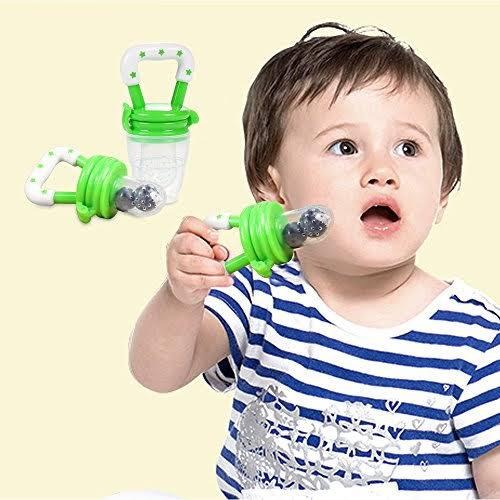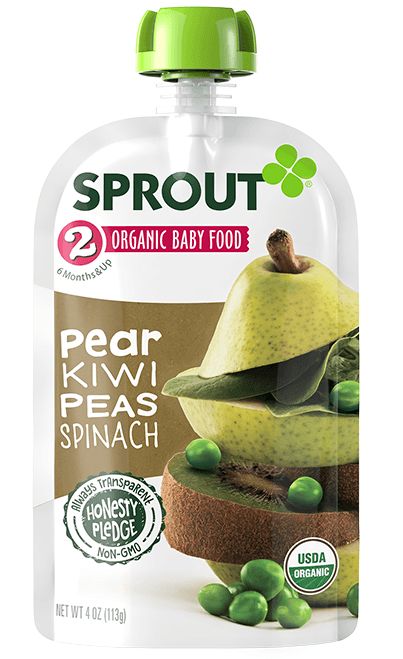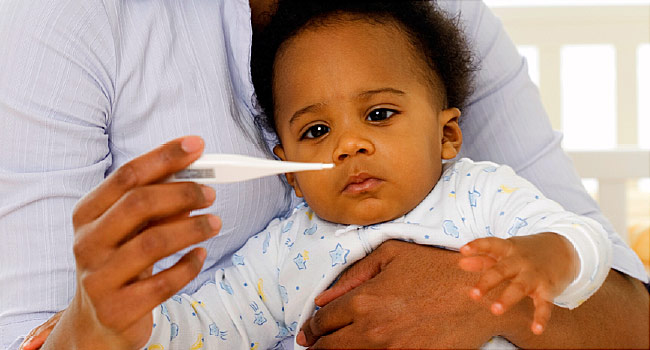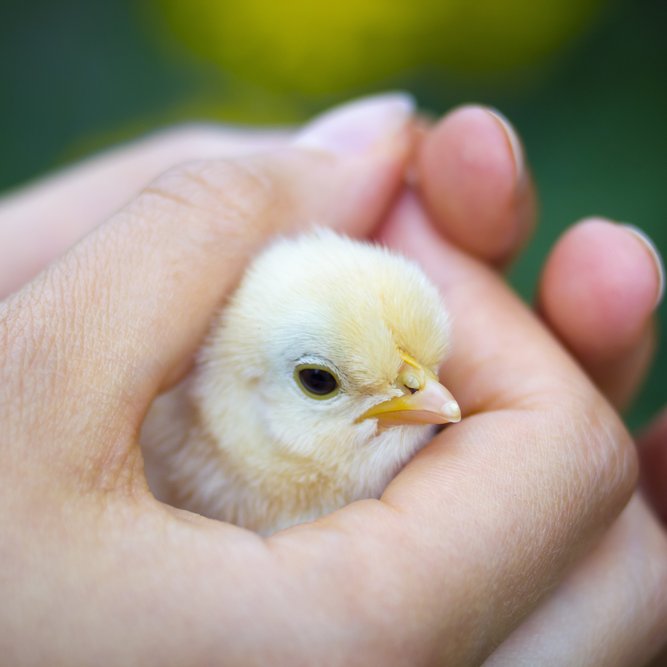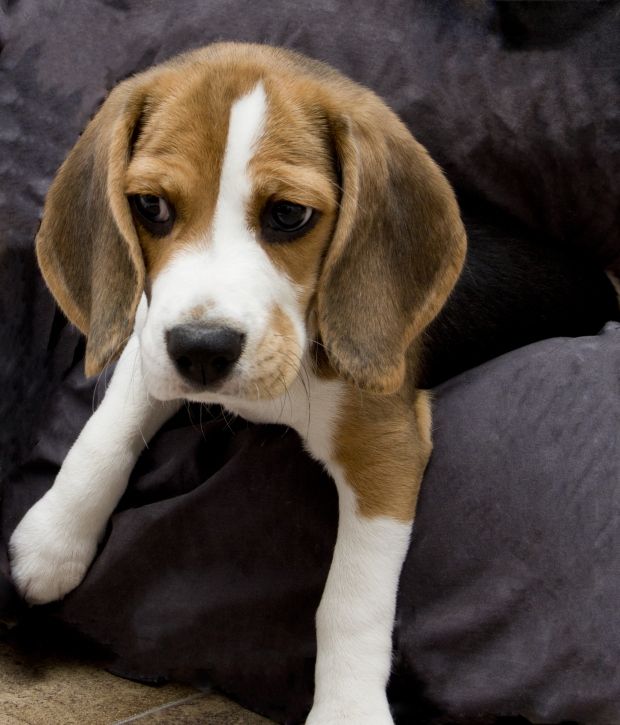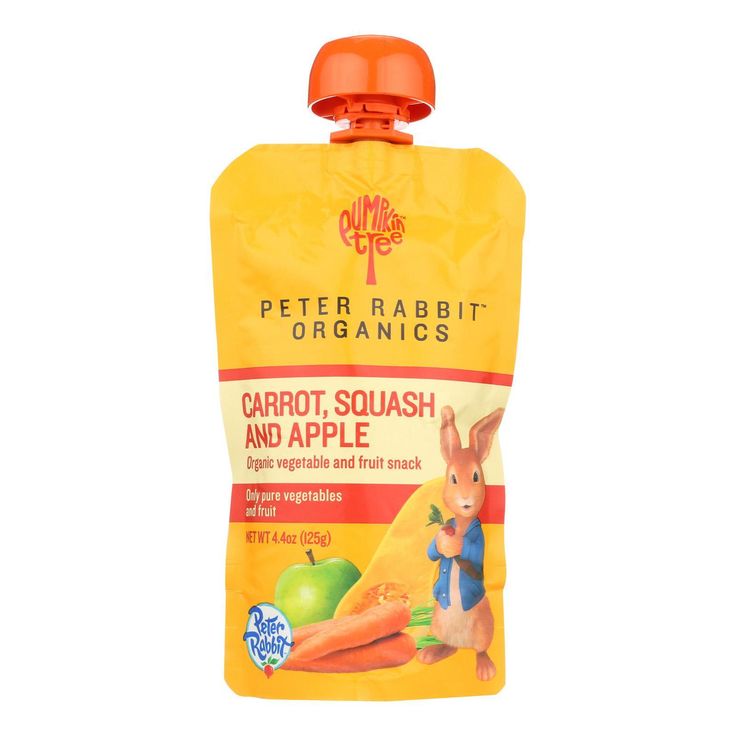What milk to feed wild baby rabbits
Caring for Newborn Baby Rabbits
IF THESE ARE WILD BABIES
It’s that time of year again. Wild babies everywhere. But are they at risk?
Wild rabbits hide their nests in plain view, often in the middle of your yard, bushes, etc. If you find a nest that has been disturbed, do the best you can to restore it and leave the babies in there. If a dog discovers the nest, do your best to restore it (with grass, leaves, whatever mama has used), make sure the kits are in there, and find a way to keep the dog(s) away from the nest. Mama will return for her babies and taking them away will seriously decrease their chance of survival. If you do not see the mama—DON’T WORRY—they only nurse their babies a few minutes a day, then they stay away so as to not draw predators to the nest.
If a kit is injured or an animal brings you an injured baby, if you have no choice but to help a baby, please do not try to care or it yourself—-get it to a rabbit vet or a wildlife rehabilitator
- Local wildlife rehabilitator: https://www.
nwrawildlife.org
- List of rabbit vets: http://rabbit.org/vet-listings/
The best thing you can do for wild babies is to leave them alone (restored to the nest) or, if injured, get them to a rabbit vet or wildlife rehabilitator.
DOMESTIC/PET RABBITS
WHERE TO PUT THE BABIES
Make the babies a soft nest area in a box with clean towels. We like to put one folded towel on the bottom and another bunched on top of that, so the babies can snuggle into it. You can also purchase soft nesting wool from a pet store and put that on top of the towel. You can also take whatever nesting material they were in and put it in the box as well. Cover the box almost entirely with a light towel, making sure that there will be enough air so the babies do not suffocate. Leaving about a one inch gap at the top is usually sufficient. Keep the babies in an out-of-the way, QUIET area, such as an adult’s bedroom. If the room temperature is between 68-72 degrees you will not need to provide extra heat, but if it’s cooler than that you will need to provide extra warmth. Use a heating pad set on low and slip it under one half only of the box. We do it this way so that the babies can move to a cooler area if it gets too warm. DO NOT put babies directly on heating pad, as babies can burn themselves very badly.
Use a heating pad set on low and slip it under one half only of the box. We do it this way so that the babies can move to a cooler area if it gets too warm. DO NOT put babies directly on heating pad, as babies can burn themselves very badly.
If the babies were with their mamma, but she is not caring for them (and you are sure she is ignoring them) you may need to separate her from them so they will not get hurt. Rabbit milk is very caloric and the kittens (baby rabbits) only nurse for a few minutes a day, so if you think that she is not caring for them based only on the fact you don’t see them feed…think again. If you do think they are being neglected, you can check: Are they cold? Are they making crying sounds for more than a few minutes before (or at) feeding time? Are they blue? Is the skin shriveled? Check for dehydration: gently pinch together the skin at the nape of the neck. If it sticks together or stays in a tent, they are dehydrated.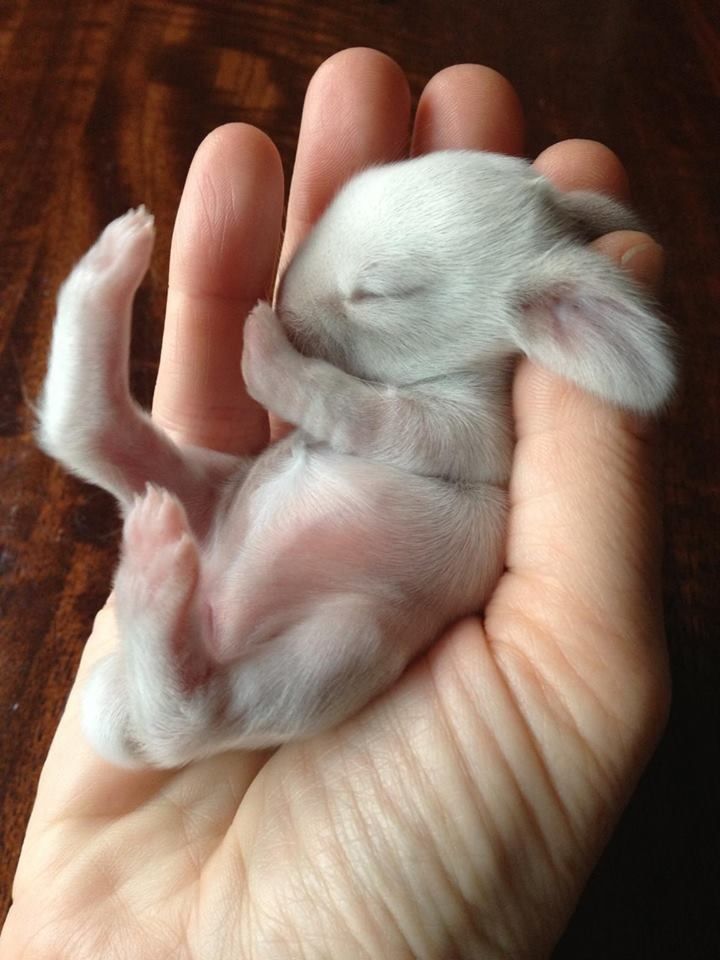 A healthy kit has a round belly, is warm, gains weight on a daily basis, and snuggles with its litter mates. If they are dehydrated, cold, losing weight or becoming injured, of course, something must be done
A healthy kit has a round belly, is warm, gains weight on a daily basis, and snuggles with its litter mates. If they are dehydrated, cold, losing weight or becoming injured, of course, something must be done
WHAT TO FEED THE BABIES
Baby rabbits should be fed Kitten Milk Replacer (KMR) or goat milk, which you can buy at pet stores, or sometimes even a local veterinarian’s office. Because rabbit milk is the most caloric of all mammals, we add in one tablespoon of 100% heavy whipping cream (no sugar) to each can of KMR. Most kits will not nurse from the baby animal bottles you can buy at stores. Instead, use a sterile oral syringe, which can be purchased at most pharmacies. A better alternative are these nipples, which come the a syringe, but you may not be able to find them locally/right away (link).
It is best to feed baby rabbits no more than twice a day, but sometimes it takes more feedings to get an adequate amount into them, especially at first.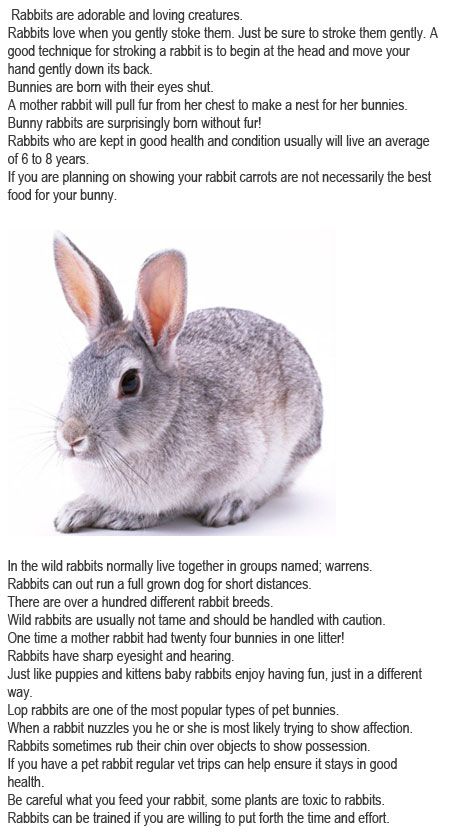
How much to feed varies greatly on what breed of rabbit you are feeding, and how big the kit is, but here is a basic guideline for the daily amount to feed a domestic rabbit who will be approximately 5-6 pounds as an adult (average rabbit size). You can increase the amounts as needed for larger breeds.
To help the kits maintain healthy gut bacteria, go to your local health food store (and get a bottle of ACIDOPHILUS. Ask for the capsules that have the “grainy stuff” inside (they are easier to mix than the “powdery stuff”) and add a bit to the formula at each feeding.
ALL amounts below should be divided into two feedings per day.
- Newborn – 1 week
- 4-5 cc formula
- 1-2 weeks
- 10-15 cc formula
- 2-3 weeks
- 15-30 cc formula
- 3-6 weeks, until weaned
- 30 cc formula
HOW DO I DO THIS?
Baby rabbits feed from their mothers while lying on their backs. You may loosely wrap baby in a soft face cloth or hand towel and lay it on your lap or in the crook of your arm. If bunny will NOT eat this way, of course, do the best you can. It is ABSOLUTELY CRUCIAL to let the baby eat at it’s own pace—especially if it is not suckling from the syringe willingly. If you squirt the liquid in too quickly you can aspirate (get liquid in) the lungs and the rabbit will suffocate.
You may loosely wrap baby in a soft face cloth or hand towel and lay it on your lap or in the crook of your arm. If bunny will NOT eat this way, of course, do the best you can. It is ABSOLUTELY CRUCIAL to let the baby eat at it’s own pace—especially if it is not suckling from the syringe willingly. If you squirt the liquid in too quickly you can aspirate (get liquid in) the lungs and the rabbit will suffocate.
Until their eyes open (10 days): After each feeding it is important to make the bunny defecate and urinate to keep the intestinal tract and urinary system running smoothly. Use a soft cloth or a cotton ball moistened with warm water and gently stroke the genital area until the bunny starts producing stool and urine. Keep stroking until the bunny stops. You are replicating the behavior of the mother rabbit who would lick her young to stimulate them to go to the bathroom. The stool will be soft and may be varying shades of green and yellow. If the urine is brown and gritty, the buns are not adequately hydrated and you need to get them to a rabbit vet ASAP—-it is an emergency. Be sure to clean baby’s mouth with a damp cloth or paper towel, so that no milk dries in the hair.
If the urine is brown and gritty, the buns are not adequately hydrated and you need to get them to a rabbit vet ASAP—-it is an emergency. Be sure to clean baby’s mouth with a damp cloth or paper towel, so that no milk dries in the hair.
Baby rabbit eyes open at about 10 days of age. You may start introducing them to hay and pellets at this point, but no veggies or fruits yet. Just leave some timothy or orchard and alfalfa hay and pellets in a corner of the box where the babies can easily get to them. Make sure it the pellets are plain, high fiber and fresh, with no added goodies such as dried banana chips or seeds. Don’t ever leave a deep water dish in which a baby could drown; instead, use something shallow and rinse and fill it frequently.
If you have any questions, please contact us.
Your Question Answered: What Do You Feed Wild Baby Rabbits?
Written by The Rabbit Hole Hay Team
Regardless of how you stumbled upon these babies, here’s some things you need to know about what to feed baby wild rabbits. Before you go about this process, it’s important to know if the baby is a jack rabbit or cottontail rabbit. Jack rabbits are even more wild and will injure themselves or can die of trauma very easily. Please seek expert advice and let a professional take care of them if this is the case.
Before you go about this process, it’s important to know if the baby is a jack rabbit or cottontail rabbit. Jack rabbits are even more wild and will injure themselves or can die of trauma very easily. Please seek expert advice and let a professional take care of them if this is the case.
1. Make Sure The Rabbit Actually Needs Help And Is An Orphan
Are you sure that these wild baby rabbits are actually abandoned? How do you know? Rabbit parents can sometimes leave their nest for up to a whole day to forage in the woods and visit with other rabbits, and only come back to briefly check in and feed. If you have been watching the hole and haven’t seen the mom for at least two days or have even checked the rabbits and noticed they are skinny and calling for help, you may need to take action.
Read this to know if the babies are actually abandoned: How to Care for Orphaned Wild Cottontail Bunnies
2. Prepare A Place For The Rabbits To Stay
Create a nest like situation for the baby rabbits. This can be created by using a blanket or towel in a rabbit cage or hutch. The bunny’s environment should be cozily warm, but not hot. Smaller bunnies may require an incubator for help.
This can be created by using a blanket or towel in a rabbit cage or hutch. The bunny’s environment should be cozily warm, but not hot. Smaller bunnies may require an incubator for help.
3. Feed The Rabbits
If the baby rabbits you rescued are infants with their eyes closed or barely any fur, you’ll need to hand feed them formula. There are different opinions on what type of milk you should feed them, how often and how to do it. However, goat milk or kitten milk replacer is typically the milk of choice. NEVER feed them cow’s milk. Just remember, wild bunny food is different than domestic bunny food.
Consider these articles for methods:
- How to Care for Orphaned Wild Cottontail Bunnies
- How to Care for a Baby Wild Rabbit
- Orphaned Baby Bunnies: Wild and Domestic
Reminder: Any wild rabbit no matter the age should have constant access to hay, water and fresh greens similar to the type are used to in their wild environment. While it is not a baby’s main food source, they may learn how to eat solid food by nibbling on it.
4. Stimulate The Bunnies To Go To The Bathroom
In order for very young baby rabbits (7 days old or less) to be able to go to the bathroom they must be stimulated. Think about how mother animals typically clean their young by licking them. Really, it serves a double purpose which is to help stimulate their organs to urinate and defecate. This might sound a little gross to you and if you’re not able to take this on then please take the rabbits to a shelter or vet.
Read this for instructions on how to stimulate a baby rabbit: Saving Wild Baby Rabbits
5. When In Doubt Take Them To A Vet Or Rabbit Shelter
If you don’t think you are able to care for the baby bunnies, are scared to do so or have noticed they aren’t doing well or one is injured, don’t mess around and take them to your local veterinarian or rabbit shelter immediately. Rabbits can pass away quickly. You don’t have time to spare if you notice something is wrong. Let the professionals take it into their own hands.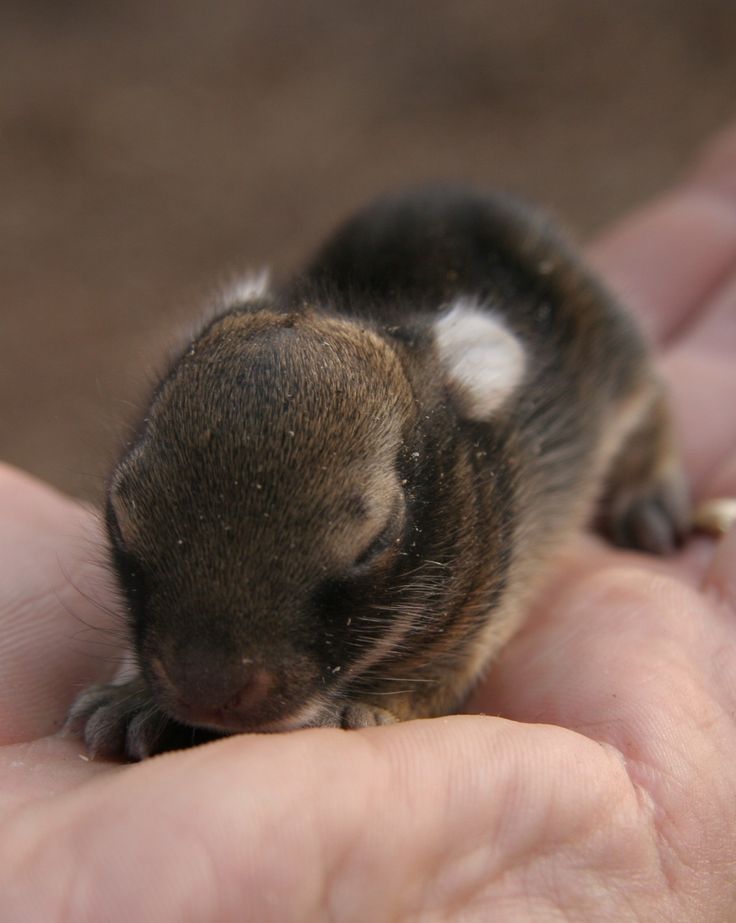
Eventually you will want to, well, maybe more like have to, let them free and out into their natural habitat again. When you take care of these bunnies make sure you keep in mind that they are wild and need to be released back to where they came from. So don't get too attached! They should not be kept as your pet unless they have an injury or will not survive on their own in the wild.
Again, this is a very big responsibility and takes a lot of time and dedication. Please consider taking the orphaned baby rabbits to an experienced rabbit shelter or veterinarian. We hope this helped answer your questions of “what do you feed wild baby rabbits?”
You can also download our Hay is for Rabbits eBook to know all about the different types of hay, the best ones to feed your rabbit based on their age, and more! That way the next time you run out of hay, you can purchase your next order with us with confidence.
Feeding rabbits, basic rules and possible problems
There are times when the owners face the task of artificially feeding rabbits. This forced measure can be caused by various reasons. The rabbit turned out to be a bad mother and abandoned the kids, or one of the kids is not eating enough and should be fed.
This forced measure can be caused by various reasons. The rabbit turned out to be a bad mother and abandoned the kids, or one of the kids is not eating enough and should be fed.
One important thing to remember is that only rabbit milk can be better than rabbit milk. When there is nothing to feed the rabbits, the owners begin to experiment. Under no circumstances should this be done! There are many wild stories when rabbits tried to feed them with condensed milk, water, honey, cow's milk, and so on. And they died. There is no need to repeat such “feats” in any case.
First, ask your friends, breeders, people on the Internet - maybe someone has a lactating rabbit during this period who could “accept” your rabbits and feed them. If this is not available, then you will have to feed the rabbits yourself.
Artificial feeding of rabbits : what can replace rabbit milk?
Let's compare the composition of milk of different animals in %:
| Animal | Content, % | ||||
|---|---|---|---|---|---|
| water | proteins | fats | lactose | salts | |
| Cat | 81. 5 5 | 9.3 | 3.5 | 4.9 | 0.7 |
| Dog | 77.0 | 9.7 | 9.3 | 3.1 | 0.9 |
| Rabbit | 70.0 | 15.5 | 10.4 | 1.9 | 2.7 |
| Deer | 65.0 | 14-20 | 17.0 | 2.8 | 1.5 |
| Ladies | 1.5 | 4.0 | 7.0 | 0.2 | - |
| Mare | 90.3 | 1.8 | 1.1 | 6.0 | 0.4 |
| Donkey | 90.1 | 1.8 | 1.4 | 6.0 | 0.5 |
| Cow | 87.3 | 3.4 | 3.6 | 5.0 | 0.7 |
| Goat | 87.9 | 3.7 | 4.0 | 4.5 | 0.9 |
| Camel | 86. 5 5 | 4.0 | 4-5 | 5.6 | 0.9 |
| Sheep | 84.0 | 5.1 | 6.1 | 4.2 | 1.0 |
| Buffalo | 83.0 | 4.6 | 7.4 | 4.2 | 0.9 |
From the table we see that rabbit milk is very different in composition from the milk of other mammals. It is rich in fats and proteins. And this means that it is almost impossible to replace it with something equally valuable. The closest in composition to it is the milk of a deer. But getting such milk will be very difficult, almost impossible.
It can also be seen from the table that cow's milk is not at all suitable for replacement. The low percentage of proteins and fats makes it unsuitable for feeding rabbits. The same goes for goat milk.
Dog milk is the closest to rabbit milk in composition after deer milk. Of course, you should not put rabbits to a nursing dog, this can end tragically. You need to buy a dog milk replacer (dog milk powder) at the pet store. And feed them. Powdered milk should be diluted in water in accordance with the instructions and heated to a temperature of ~ 36 degrees. You can check the temperature of milk on the bend of your elbow. You need to feed rabbits from a pipette or from a thin insulin syringe without a needle. This should be done very carefully, in small portions. Make sure that the liquid does not get into the spout, and also that the rabbit has time to swallow and does not choke.
You need to buy a dog milk replacer (dog milk powder) at the pet store. And feed them. Powdered milk should be diluted in water in accordance with the instructions and heated to a temperature of ~ 36 degrees. You can check the temperature of milk on the bend of your elbow. You need to feed rabbits from a pipette or from a thin insulin syringe without a needle. This should be done very carefully, in small portions. Make sure that the liquid does not get into the spout, and also that the rabbit has time to swallow and does not choke.
It is especially important not to overfeed the baby rabbit. The degree of "satiety" is determined by the baby's tummy. A well-fed rabbit's tummy will be tight and without wrinkles. In the absence of dog milk powder, you can buy cat milk. Also, if you or your friends have a lactating cat, you can try to charge her feeding rabbits : "attach" them to her. There were cases when cats accepted rabbits very well and fed them.
Photo: Allwetterzoo Munster
How to feed baby rabbits without a female rabbit from the first days of life
From time to time farmers have to face the problem of how to feed baby rabbits without a female rabbit. The reasons for the need may be different, but the solution is always equally necessary. In this position, the efficiency and fidelity of actions directly affect the survival of babies. Any mistake can lead to the death of the offspring in just a few hours.
The reasons for the need may be different, but the solution is always equally necessary. In this position, the efficiency and fidelity of actions directly affect the survival of babies. Any mistake can lead to the death of the offspring in just a few hours.
How to feed baby rabbits without a female rabbit
Article contents
- 1 Is it possible to feed baby rabbits without a female rabbit?
- 2 What can replace rabbit milk?
- 3 Rules for feeding
- 4 Artificial feeding rabbits by age
- 4.1 from birth to 5 days
- 4.2 from 6 to 14 days
- 4.3 Video - how to feed the rabbit
- 4.4 from 15 days
- 5.1 Prices for rabbit feed
- 8.1 Prices for rabbits
is possible
It is possible to feed offspring of rabbits without a female, although the process will require a waste of time and money.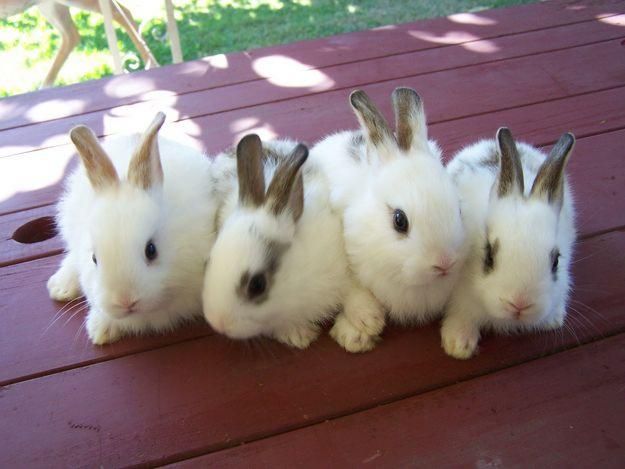 The organization of such a meal obliges you to purchase some accessories, follow schedules, be with the kids a lot. The main difficulties occur in the first weeks of the life of rabbits. As they grow older, the need for constant support disappears, the animals become independent.
The organization of such a meal obliges you to purchase some accessories, follow schedules, be with the kids a lot. The main difficulties occur in the first weeks of the life of rabbits. As they grow older, the need for constant support disappears, the animals become independent.
Babies with a rabbit
Artificial feeding is considered undesirable unless absolutely necessary. Wrong actions can reduce the percentage of survival. Third-party nutrition, human care will not completely replace mother's milk and care. Meanwhile, there are cases when orphaned babies grew up stronger, thanks to the hard work of breeders.
Newborn rabbit
Procedure required for certain problems:
- death of female . Sometimes the rabbit dies during or after childbirth. It is very difficult to predict the sad outcome;
- atrophied parental instinct . Often occurs in the first litter in young individuals. The newly-made mother does not want to feed her offspring.
 In most cases, the instinct can be awakened forcibly by holding the female several times in the process of feeding the babies. However, there are times when no tricks help;
In most cases, the instinct can be awakened forcibly by holding the female several times in the process of feeding the babies. However, there are times when no tricks help; - passion for hunting . Restless rabbits can abandon children within a day after giving birth. They begin to run around the living space, furiously looking for food. In such impulses, rabbits often die from accidental trampling by their own mother. The problem is solved by provocation. Mating is carried out with a male incapable of conception. After that, the female can calm down. If the attempt is unsuccessful, artificial feeding cannot be avoided;
- sore nipples . It is also more common in young rabbits. Roughened skin does not allow milk to pass quietly, the process causes severe inconvenience to the mother and she stops letting offspring;
- strong odors . Rabbits are sensitive to foreign odors. The most unpleasant for them are shades of alcohol, perfume, household and technical liquids.
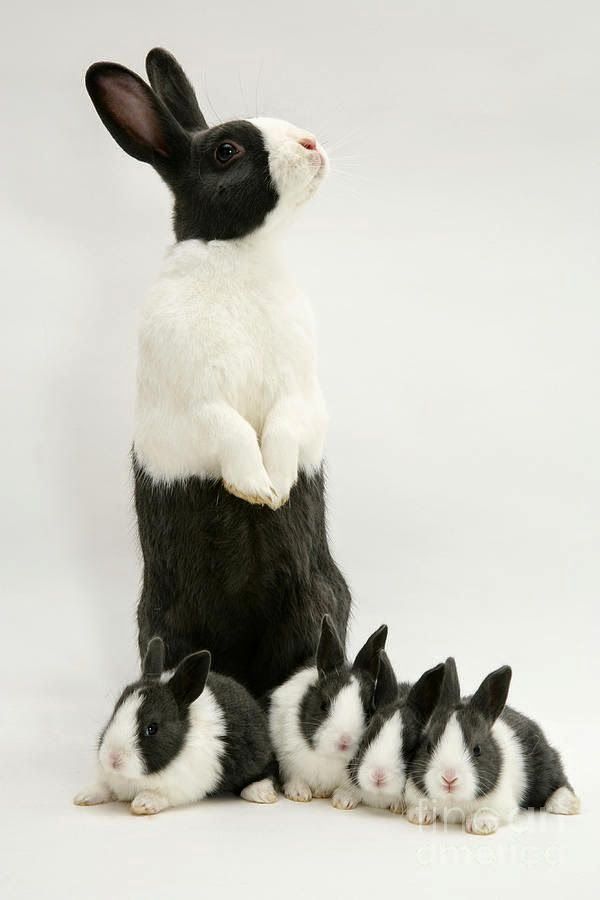 Sometimes the smells of other animals living in the neighborhood play a cruel joke. Discomfort leads to the damping of instincts.
Sometimes the smells of other animals living in the neighborhood play a cruel joke. Discomfort leads to the damping of instincts.
Feeding of young rabbits by another mother
In these situations, if possible, try placing the babies on another mother. However, not every rabbit will willingly accept someone else's offspring. In addition, a large number of babies will lead to exhaustion of the female. Therefore, experienced farmers prefer to immediately get down to business on their own.
See also: The rabbit does not feed the rabbits: what to do?
It happens that the rabbit refuses to feed newborns. Everyone who breeds rabbits should know what to do in such a situation. Why the rabbit does not feed the rabbits and how to deal with the problem, we will tell in the article.
What can I substitute for rabbit milk?
Newborn rabbits are recommended to be fed quality substitutes. This is the only way they can get the maximum amount of nutrients. Valid options are:
This is the only way they can get the maximum amount of nutrients. Valid options are:
As for cow's milk, opinions differ. Some farmers consider it categorically unacceptable for rabbits. Other breeders claim that such a substitution is possible when there are no other options. Cow's milk differs significantly from rabbit's in composition, fat content, and ability to be digested. In its pure form, it does not satisfy the needs of small rabbits. Some sources suggest mixing whole cow's milk with condensed milk (preferably without sugar) 4 to 1. But this mix is classified as emergency.
Cow's milk can be used when there are no other options
Rules for feeding
Rabbits are born blind, without hair on the body, weighing about 60 g. Without the ability to see and move freely, nutritional skills are absent. Babies are completely defenseless, so the loss of a nursing mother is a very dangerous phenomenon for them. A person must perform the functions of a rabbit.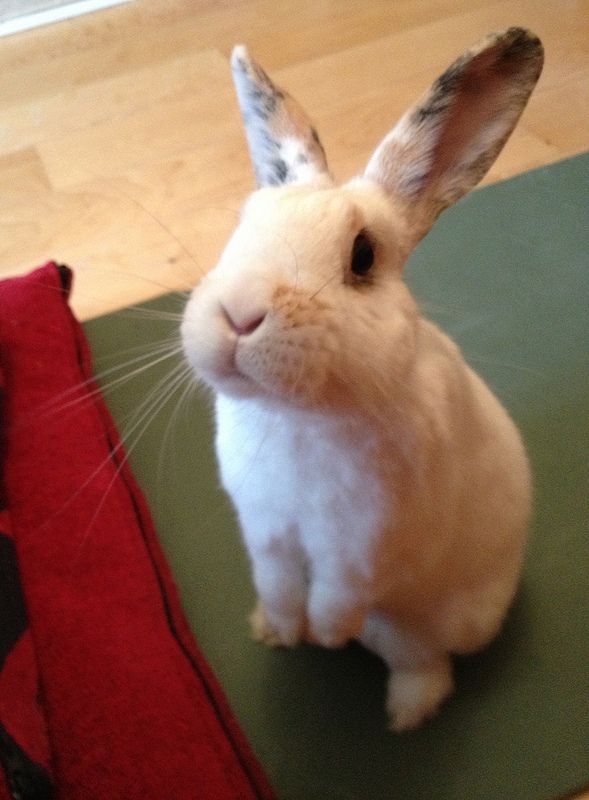 You will need to master certain skills, acquire inventory.
You will need to master certain skills, acquire inventory.
Newborn rabbits
In the first days of life, babies need a nipple. It can be played by:
- large pipette;
- 20 ml syringe without needle;
- clean bottle of eye drops;
- small baby bottle;
- special kit for animal feeding.
Feeding set 1
Syringe and drop bottle have been improved by craftsmen for easy feeding. The rubber cap from the pipette is put on the spout of the selected container. Previously, several punctures are made in the rubber. In store kits there is a special syringe and tips of different sizes. As the rabbits grow, the devices can be changed, moving from a pipette to a bottle. From day 20, most babies begin to eat from a saucer on their own.
Feeding set 2
Feeding should be built as close to natural flow as possible. The more accurately the details are copied, the faster the animals will acquire instincts.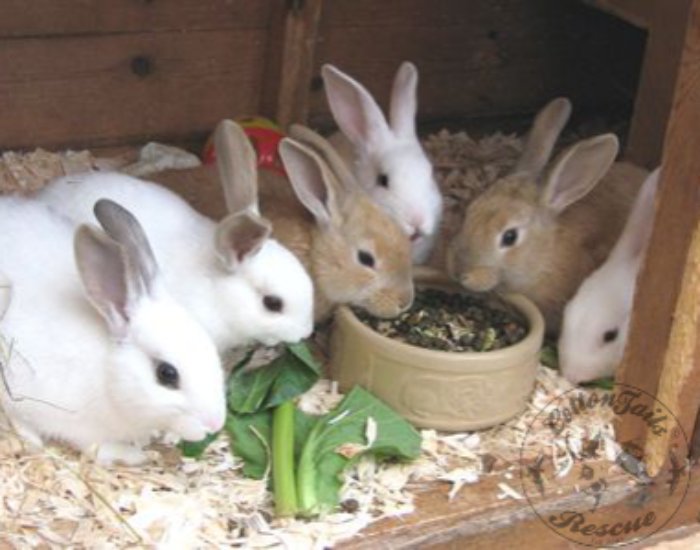 Until the eyes open, newborns show little reaction to the artificial nipple. Milk has to be poured into the mouth. It is important to squeeze out the liquid gradually so that the baby does not choke. The first 2-3 days it is better to start feeding by smearing milk around the mouth. The rabbit will lick it himself. For inactive individuals, the procedure is repeated several times. If the rabbit perks up when he feels the taste of food, you can already proceed to the infusion of a few drops.
Until the eyes open, newborns show little reaction to the artificial nipple. Milk has to be poured into the mouth. It is important to squeeze out the liquid gradually so that the baby does not choke. The first 2-3 days it is better to start feeding by smearing milk around the mouth. The rabbit will lick it himself. For inactive individuals, the procedure is repeated several times. If the rabbit perks up when he feels the taste of food, you can already proceed to the infusion of a few drops.
Feeding should be built as close as possible to the natural flow
A blind baby can eat no more than 1 ml of milk at a time. The stomach should not be full. Overfeeding threatens with gastric disorders, inflammation of the respiratory system. The rabbit must be held vertically in the hand, without squeezing the body. The liquid is stored in the refrigerator for no more than 72 hours, heated before the procedure to 37-38°C. The mixture is always prepared fresh.
Keep baby upright
The easiest way to determine the optimal feeding times is to observe the behavior of the young. Well-fed cubs behave calmly, quietly, sleep a lot. In a hungry state, they become restless, try to move around in search of a mother and squeak.
Well-fed cubs behave calmly, quietly, sleep a lot. In a hungry state, they become restless, try to move around in search of a mother and squeak.
Artificial feeding of rabbits according to age
Each age of rabbits requires its own feeding schedule. The frequency is adjusted according to the speed of digestion of food. Appetite increases with the growing body. By the end of the first week, babies are already able to overeat, so following the rules is necessary for their health. Until the 30th day, the diet consists only of milk.
Up to a month, only milk is included in the diet
From birth to 5 days
A newly born rabbit is given literally 1 drop of liquid. During the day, the number of drops is increased gradually in 5-6 visits. The animal does not yet have a good swallowing reflex, so special care is needed. From the second day it is enough to feed 4-5 times. By the end of the period, the baby should double its birth weight (120-180 g for different breeds).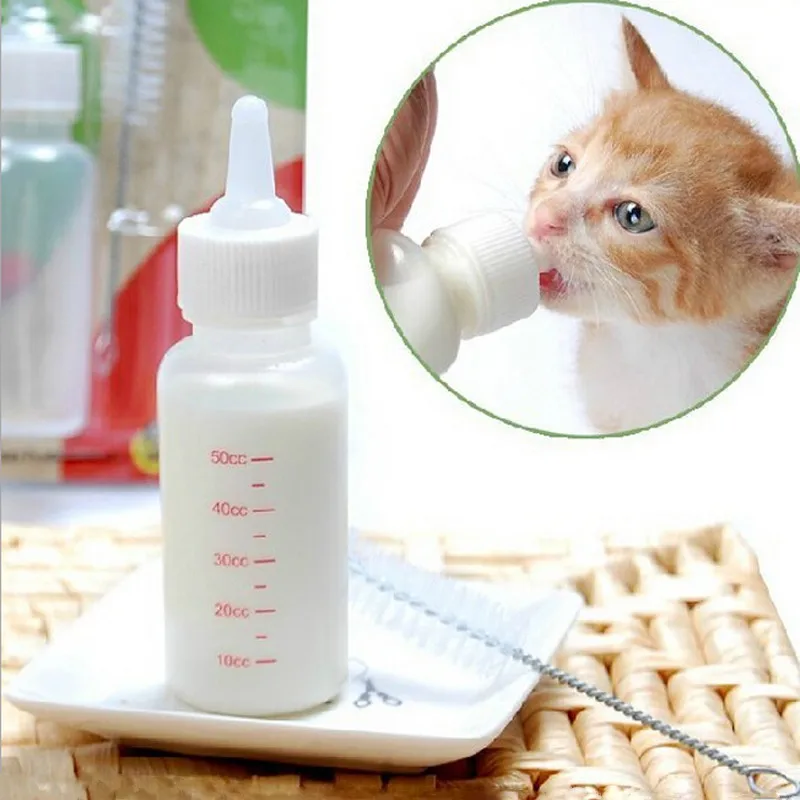 On the fifth day, food is given 4 times.
On the fifth day, food is given 4 times.
Pipetting
Days 6 to 14
From day 6, young rabbits are fed three times a day. This mode lasts up to 2 weeks of life. During this time, the weight of the babies reaches 200-260 g. Portions gradually grow along with the animals.
Syringe nipple
Video - How to feed a rabbit through a syringe
From 15 to 30 days
On days 15 and 16, individuals are transferred to a two-time diet. They observe their behavior, if there is not enough food, add a little mixture in the form of a third feeding. From the 17th day onwards, portions become impressive, the body prepares for the adult regimen, so two feedings do not exceed. By day 30, the rabbits weigh about 500 g. Depending on the breed, the weight may be slightly less or more. Weaning from the nipple begins by the end of the third week. Early maturing species are often ready for the introduction of other products already on the 20-25th day. Readiness can be tracked by the behavior and condition of the teeth. When milk teeth are almost completely replaced by molars, interest in solid food wakes up, the animal is transferred to a new food.
Depending on the breed, the weight may be slightly less or more. Weaning from the nipple begins by the end of the third week. Early maturing species are often ready for the introduction of other products already on the 20-25th day. Readiness can be tracked by the behavior and condition of the teeth. When milk teeth are almost completely replaced by molars, interest in solid food wakes up, the animal is transferred to a new food.
Baby bunny drinking milk from a bottle
Increase the amount of milk as it grows. The larger the breed, the larger the single portion.
| Feeding rate per 1 individual per day (for 1 feeding) | |
|---|---|
| days 1-7 | 5 ml (1 ml) |
| 8-14 days | 20 ml (5 ml) |
| 15-20 days | 20-26 ml (10-13 ml) |
| 21-30 days | 30-50 ml (15-25 ml) |
What to feed baby rabbits per month?
When the rabbits gain strength, the teeth will get stronger, they begin to connect solid food. Some farmers completely exclude milk by 31 days. Others prefer to keep it as a supplement in small amounts. Experts recommend leaving dairy food only with weight loss.
Some farmers completely exclude milk by 31 days. Others prefer to keep it as a supplement in small amounts. Experts recommend leaving dairy food only with weight loss.
Hay is added to the diet
New food is offered to rabbits from the 3rd week of life. Even during the period of milk nutrition, small heaps of hay are placed on them. It is important to observe the baby's stool. The slightest signs of diarrhea serve as a stop signal for feeding. Disorders of the gastrointestinal tract for these animals are very dangerous, since digestion after them may not recover. If the introduction was successful, gradually add small grass, a few granules of compound feed, a pinch of grated carrots. So the transition to adult food is as smooth as possible.
Feed prices for rabbits
Feed for rabbits
The intestines of a monthly rabbit are able to digest food without stagnation. The basis of the diet is now made up of granular mixtures, greens and hay, oatmeal flakes, vegetables, root crops.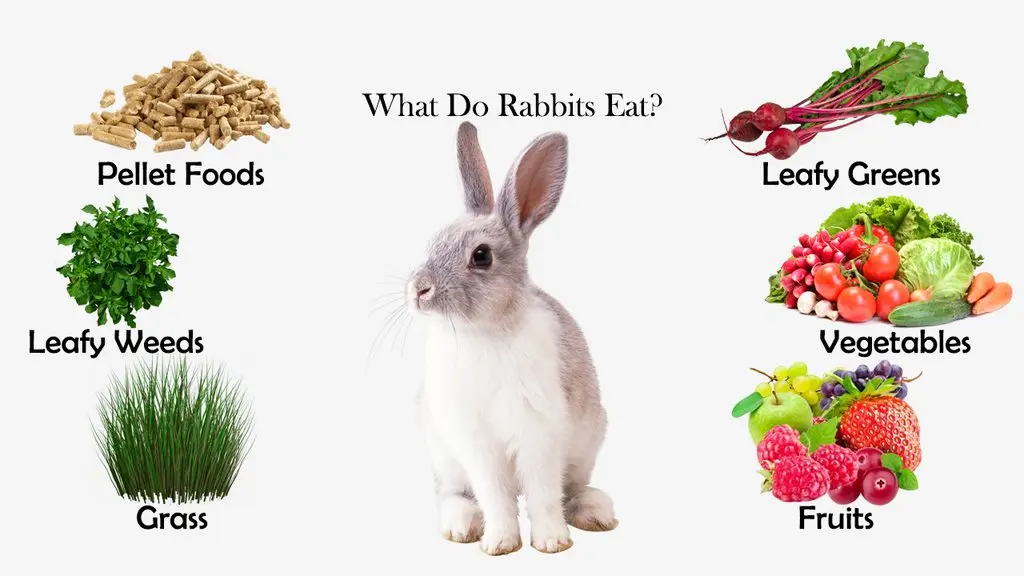 All food must be fresh.
All food must be fresh.
Babies start eating on their own
Granules include the necessary vitamin premixes. Their size varies, so a serving per individual is considered 3% of the individual's weight. Carrots, cabbage leaves are crushed at first, then they begin to be given in large pieces. Beets, potatoes, turnips are given only for fodder, not more than 1-2 times a week. Dry food must be moistened, otherwise they irritate the respiratory tract of rabbits. Animals should always have access to clean drinking water.
Monthly rabbit food pyramid
Only hay and water are kept in the feeding area at all times. The rest of the food is laid according to the regimen, the remains are removed daily.
| Feeding norms for a rabbit from 1 month. Gram per day for 1 individual | |
|---|---|
| Concentrated granules | 40-60 g |
| Hay | 120-150 g |
| Grass | 300-500 g |
| Vegetables, root crops | 150-200 g |
In winter, the norms are calculated according to the upper permissible limit. In summer, the amount of grass is increased, and the granular feed is reduced to a minimum.
In summer, the amount of grass is increased, and the granular feed is reduced to a minimum.
Granular food
It is forbidden to feed baby rabbits with sprouted potatoes, wild herbs, branches of unknown trees. Many breeds are poisonous to these animals; it is necessary to study acceptable plants in advance. Food with mold, rot, dirt, fungus, frozen areas can also cause irreparable harm to the pet's body.
See also: What not to feed rabbits
In this article, you can get acquainted with prohibited foods for rabbits, as well as what food will keep their health in order.
Feedings
The milk of a healthy rabbit is able to provide the offspring with all the necessary vitamins. On artificial feeding, newborn animals need help in the form of feeding. Ready mix substitutes often already contain premixes. In their absence, special preparations are added to natural milk on their own:
Premixes may also be present in pelleted feed. From day 31, you need to make sure that the total amount of top dressing is within the acceptable range.
From day 31, you need to make sure that the total amount of top dressing is within the acceptable range.
Experienced zookeepers recommend giving the following mixture during the feed change period:
- 4 parts of hay or grass meal;
- 3 parts barley;
- 2 parts peas or corn;
- 2 parts sunflower meal;
- 1 part wheat bran.
Homemade dressing
All ingredients are ground into coarse flour and given a pinch from the 20th day. From day 31, all or part of the pelleted feed can be replaced with this mixture.
Advantages and disadvantages of artificial feeding of young animals
Artificial feeding is always a last resort when rearing offspring. The main disadvantage of this approach is the inability to give the kids the whole set of necessary trace elements. All substitutes remain only close to rabbit milk. A product from other animals, mixtures, one way or another, remain unbalanced specifically for rabbits.
Baby rabbits get all the necessary nutrients from natural feeding. This process often causes difficulties, slows down the formation of the swallowing reflex. In addition, there is a risk of making incorrect actions and harming the animal, and getting a substitute for native milk can be problematic and expensive. Another disadvantage is the need for a person to be present almost all day.
Plus of artificial feeding - unpretentiousness of rabbits in terms of nutrition
The main advantage of artificial feeding is the unpretentiousness of rabbits in terms of nutrition. Such animals quickly get used to new products, do not refuse top dressing because of the unusual taste, and have a good appetite. It is also easier to develop the habit of feeding on a schedule, to regulate the content of vitamins for individual ears.
Care of formula-fed rabbits
Immunity in formula-fed rabbits develops much more slowly than in offspring growing on mother's milk. In connection with this fact, increased requirements are imposed on the maintenance of babies.

